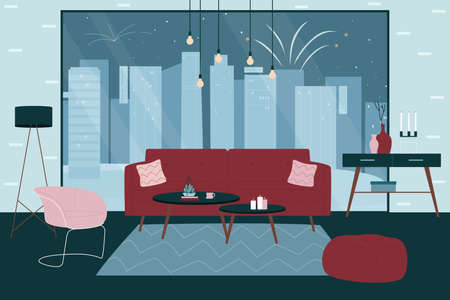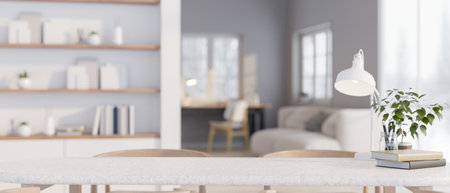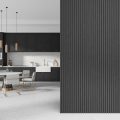Maximizing Natural Light
When designing an open concept living room that flows effortlessly into other spaces, making the most of natural light is essential. In American homes, bright and airy interiors are highly valued for their welcoming vibe and energy efficiency.
Tips for Harnessing Windows
Large windows are a hallmark of open concept designs. Opt for expansive, unobstructed windows that allow sunlight to fill your living area and spill over into adjacent zones like the dining or kitchen space. If privacy is a concern, consider sheer curtains or top-down shades that soften light without sacrificing brightness.
Incorporating Glass Doors
Glass doors—such as sliding patio doors or French doors—blur the boundary between indoor and outdoor areas while keeping spaces visually connected. They enable daylight to penetrate deeper into your home, boosting the sense of openness and continuity across rooms.
The Strategic Use of Mirrors
Mirrors are a designer’s secret weapon for amplifying natural light. Place mirrors opposite or adjacent to windows to reflect sunlight and brighten darker corners of your open concept layout. A well-positioned mirror can make smaller spaces feel larger and ensure light reaches every nook.
Pro Tip
Think about the path of the sun throughout the day and arrange furniture to avoid blocking light flow. By thoughtfully leveraging windows, glass doors, and mirrors, you’ll create a luminous environment where your living room seamlessly connects with surrounding spaces.
2. Defining Spaces without Walls
Open concept living is all about fostering connection and flexibility, but even the most spacious layouts benefit from subtle cues that define each area’s purpose. Instead of erecting walls, homeowners can use thoughtful design elements to distinguish functional zones—like the living room, dining space, and kitchen—while still preserving a sense of openness and flow.
Creative Strategies for Zoning Open Concept Spaces
Americans love their open floor plans, but we also appreciate clear organization. Here are some creative yet practical ways to delineate spaces:
| Zone | Differentiation Technique | Why It Works |
|---|---|---|
| Living Area | Area rugs, distinct lighting (like floor lamps), furniture grouping | Creates a cozy atmosphere and visually anchors the seating arrangement |
| Dining Space | Pendant lighting above the table, statement centerpiece, change in flooring material or color | Highlights the dining zone as a gathering spot without barriers |
| Kitchen | Island or breakfast bar, unique backsplash or cabinetry finish, open shelving as a soft divider | Makes the kitchen feel purposeful and separate while remaining accessible |
Using Color and Texture for Subtle Separation
Selecting a cohesive color palette across your open plan is key for unity, but introducing accent colors or textures in specific areas can help differentiate them. For example, you might opt for navy blue bar stools at the kitchen island and a bold patterned rug in the living room—both tie into your overall scheme while lending each space its own personality.
The Power of Lighting Layers
Layered lighting not only adds ambiance but also helps clarify zones. Use dimmers on overhead lights for flexibility, install under-cabinet lighting in the kitchen for task work, and choose table lamps or sconces to create intimate nooks in the living area. This approach ensures every zone feels intentional yet interconnected—a hallmark of American open concept living.

3. Consistent Flooring and Color Palette
One of the most effective ways to create a seamless flow between your open concept living room and adjacent spaces is by choosing consistent flooring and a cohesive color palette. Using the same or similar flooring materials—such as hardwood, luxury vinyl plank, or large-format tile—across all connected areas visually unifies the spaces and eliminates abrupt transitions that can disrupt the open feel. If you prefer area rugs for added comfort or style, opt for rugs with complementary colors and patterns that echo the overall design scheme without creating visual barriers.
When it comes to color palette, select two to three main hues and carry them throughout your living room, dining area, kitchen, and other adjoining spaces. Neutral shades like soft grays, warm beiges, or crisp whites work well as foundational colors, while accent tones can be introduced through furnishings, artwork, or accessories. This approach allows each zone to retain its unique function but ensures the entire open concept area feels harmonious and thoughtfully designed.
For homeowners in the U.S., this strategy also makes updating seasonal decor or changing accent pieces easier—since your base palette remains consistent, swapping out pillows or throws for a new look won’t disrupt the overall flow. By prioritizing unified flooring and a carefully curated color scheme, you’ll achieve an inviting environment that feels both expansive and cohesive, perfectly suited to modern American lifestyles.
4. Furniture Placement for Easy Movement
Strategically arranging your furniture is key to creating a seamless flow between your open concept living room and adjacent spaces. Thoughtful placement not only enhances movement but also encourages natural conversation and interaction throughout the area.
Prioritize Clear Pathways
Start by identifying the main routes people will use to move through your open space. Avoid placing large pieces of furniture in these pathways. Instead, position sofas and chairs so that they define zones without blocking access between them. This makes transitioning from the living room to the dining area or kitchen effortless.
Group Seating for Conversation
Arrange seating—such as sofas, loveseats, and accent chairs—in small clusters to foster conversation. Angle seats toward each other and keep them close enough for comfortable interaction, but far enough apart to maintain a sense of openness. Use coffee tables or ottomans as central anchors within these clusters.
Multi-Functional Pieces
Incorporate multi-purpose furniture to maximize function without overcrowding the space. For example, benches with storage can double as extra seating and declutter the area, while lightweight stools can be easily moved wherever needed.
Furniture Arrangement Tips Table
| Area | Suggested Furniture Placement | Purpose |
|---|---|---|
| Main Walkways | No large furniture; keep at least 36” wide paths | Unobstructed movement |
| Living Zone | Sofa facing focal point (TV or fireplace), side chairs angled inward | Promote conversation & relaxation |
| Transition Spaces | Use slim consoles or open shelving instead of bulky cabinets | Visual separation without blocking flow |
| Dining Area Adjacent | Keep chairs easily accessible, leave room to pull out seats comfortably | Smooth transition for meals & gatherings |
Keep Flexibility in Mind
Select lightweight or modular pieces that can be reconfigured for larger gatherings or daily needs. This flexibility helps maintain a functional layout even as your activities change.
The Bottom Line
A well-planned furniture arrangement supports both practical movement and social connection in your open concept home. By keeping pathways clear, grouping seating thoughtfully, and choosing versatile pieces, you’ll enhance comfort and cohesion across all connected spaces.
5. Incorporating Multi-Functional Elements
When designing an open concept living room that seamlessly connects with adjacent spaces, integrating multi-functional elements is key to maintaining both visual harmony and practical usability. Choosing the right pieces ensures that each zone supports a range of activities without creating clutter or disrupting the flow.
Integrated Storage Solutions
Opt for built-in shelving units or wall-mounted cabinets that blend effortlessly with your décor. These not only provide ample storage for books, media, or decorative items but also help define the boundaries between different areas without using bulky partitions. Consider low-profile credenzas or benches with hidden compartments to tuck away blankets, games, or electronics, keeping surfaces clear and streamlined.
Flexible Furniture Choices
Select furniture that adapts to changing needs and gatherings. Modular sofas can be rearranged to suit intimate family nights or larger social events. Nesting tables, collapsible desks, and ottomans with storage offer versatility without overwhelming the visual space. For dining and work zones adjacent to your living area, look for extendable tables or rolling carts that can be stowed away when not in use.
Maintaining Visual Continuity
To avoid visual clutter, choose furniture with clean lines and finishes that complement your existing palette. Open-back shelving can act as subtle dividers while allowing light and sightlines to flow freely between spaces. Use matching baskets or bins on shelves for a cohesive look and easy organization.
Supporting a Dynamic Lifestyle
By thoughtfully incorporating multi-functional elements, you create an environment that accommodates everyday life—whether it’s entertaining guests, working from home, or relaxing with family—while preserving the seamless transition between your open concept living room and the rest of your home.
6. Personalizing with Decor and Accessories
Personal touches are what make an open concept living space feel like home while still maintaining a cohesive flow. When it comes to decor and accessories, thoughtful choices ensure your style shines through without disrupting the harmony of your layout.
Artwork That Connects Spaces
Select artwork that reflects your personality but also speaks to the overall color palette and theme of the adjoining rooms. Large-scale pieces can act as focal points, helping to subtly define spaces without the need for physical dividers. Consider a gallery wall that transitions from the living area into the dining or kitchen space for a sense of continuity.
Area Rugs for Defined Comfort
Rugs are powerful tools in open concepts—they anchor furniture groupings and create visual boundaries. Choose rugs that complement each other in pattern, texture, or color. For example, coordinate a bold living room rug with a more subdued one in the adjacent dining area to keep spaces connected but distinct.
Lighting Layers for Ambiance
A mix of lighting—think pendant lights over a kitchen island, a statement chandelier in the living room, and floor lamps near reading nooks—adds warmth and dimension. Use dimmers and smart bulbs to adjust lighting for different moods or activities throughout your open space, enhancing both function and ambiance.
Greenery as a Unifying Element
Plants bridge gaps between zones, bringing life and freshness into every corner. Use similar planters or repeat specific types of foliage across your open layout to establish visual unity. Tall potted plants can also serve as organic partitions that don’t disrupt sight lines.
Keep It Balanced
While expressing your personal taste is important, avoid overcrowding surfaces or mixing too many styles. Stick with a consistent design language so each accessory feels intentional rather than random. By balancing individuality with cohesion, you’ll create an inviting open concept living room that flows naturally into every connected space.


